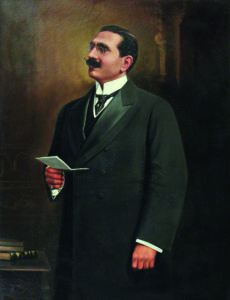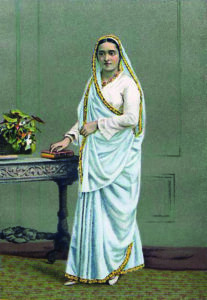 The Daguerre type and other pioneering photographic equipment of the mid-19th centuries could not do justice to the portraits of our rigid, somber-faced grand and great-grand parents, mainly due to the subject’s restricted movements while facing the huge, cumbersome, cavernous cameras, with the cameramen hidden behind the apparatus, covered with a couple of yards of black funereal cloth! The quality of photography improved immensely by 1910, with the advent of Eastman Kodak’s Folding view, Bellows type camera. But then, this is not about cameras.
The Daguerre type and other pioneering photographic equipment of the mid-19th centuries could not do justice to the portraits of our rigid, somber-faced grand and great-grand parents, mainly due to the subject’s restricted movements while facing the huge, cumbersome, cavernous cameras, with the cameramen hidden behind the apparatus, covered with a couple of yards of black funereal cloth! The quality of photography improved immensely by 1910, with the advent of Eastman Kodak’s Folding view, Bellows type camera. But then, this is not about cameras.
Looking at the pics without prejudice, the grannies or the grandpas must have been just as hep or trendy as any today – the gara-bordered saris, with ‘saurre’ and ‘mathabanoos’, or long-laced sadras flowing out of the ‘budian’, (Parsi blouse), with detachable buttons in silver or gold, embellished with pearls, rubies or diamonds, a long earing only on one earlobe as the other ear was covered by ‘saurre’, and often long strings of pearls, and stocking-feet shod in pert little shoes, with heels. I had seen my granny’s wedding shoes made of brocade, similar to one worn by Audrey Hepburn in ‘My Fair Lady’. Granny rarely wore them. Ladies were a colorful lot when they stepped out, as my granny would say, “Chalo dariye jaiye”, or go promenading, or riding in their coaches, buggies, or victorias. Those black-and-white pics did no justice to these Victorian or Edwardian belles.
Men, almost always mustachioed, sometimes sporting a goatee or a well trimmed French beard, looked formidable in their ‘jamo’ and ‘pichori’ or then the ‘duglo’ – a bund-gala, long-coat worn about three inches above the knee. Usually black or brown duglas were made of soft, durable and silky Alpaca wool (fleece of a south American, camel-like animal) and the rarer white duglas made of ‘white duck’ – a glossy, shiny, cotton cloth. At the turn of the 19th century, the duglas opened up with short lapels – about 12 inches, worn over a wing-tipped detachable collar, white shirts and thickly knotted necktie or bow ties, giving the Parsi apparel an Edwardian look. Despite the fun and humour within the clothing, the apparels made them look quite stern and stiff, like an English school headmaster about to come down with six of the juiciest whacks of a fine cane upon errant boys caught pilfering boiled eggs from the school kitchen!
A fine example of this look was shown in the portrait of Sir Dhunjibhoy Bomanji, with pomaded mane of hair and a pince-nez perched on the handsome Parsi nose below which was a luxuriant moustache similar to the one sported by Monsieur Hercule Poirot, the detective created by Agatha Christie. Quite the Ladies’ Man, I’m sure he must have painted the town red with Lady Frainy Bomanji! Once at a charity event in London, Sir Dhunjibhoy, generous as ever, made the highest bid to plant a kiss on the forehead of the then ruling actress! Boy, oh Boy! What a smacker it must have been! Leave it to a Parsi to do his job whole-heartedly! Despite being a historian of sorts, I cannot comment upon the aftermath of that kiss, as to how our gallant knight must have said ‘good night’ to the fair Lady Frainy, upon reaching home!
Edwardian Parsi ladies wore sarees with highly ornate boarders, longer blouses, long sleeves that my granny used to call the ‘Royal Sleeves’ and high collars. The head was always covered with ‘sourre’, over the inevitable mathabanoo. Young girls wore knee-length frocks, a pill-box type of headwear, about 2 inches high, having a diameter of about four inches, perched atop the head and held in place by an elastic bend going under the chin, with stockings shod in black ballerina strappy shoes. These pill-box caps were rather ornate with strips of sari borders affixed on the circumference.
 During the Victorian era and later too, young school girls also would go draped in saris even to schools. A pity that today’s grannies, however youngish they may be, are seen at weddings and navjots in evening gowns or Punjabi suits despite having a goodish stack of elegant saris, lying appreciated and unused in their antique cupboards, many even perhaps family heirlooms! Men too, rarely wear duglis and pagris or phentas. A pity! A tradition lost!
During the Victorian era and later too, young school girls also would go draped in saris even to schools. A pity that today’s grannies, however youngish they may be, are seen at weddings and navjots in evening gowns or Punjabi suits despite having a goodish stack of elegant saris, lying appreciated and unused in their antique cupboards, many even perhaps family heirlooms! Men too, rarely wear duglis and pagris or phentas. A pity! A tradition lost!
During the post WWI era, Parsi ladies embraced western style dresses, with plunging necklines and soaring hemlines! This a common phenomenon that occurs every few decades. Exposing the once unmentionable areas would have had swooning ladies in need of smelling-salts fifty years ago. But things change… Late forties – blouses (badians) came up but exposing the bellybutton was still taboo (though not for long). The Fifties had Parsi ladies change sari-fashions, from draping their sarees over the right shoulder (chatta-chera-ni-sari), to draping the ‘pallu’ over the left shoulder (Undha-chera-ni-sari). Initially frowned upon by the traditionalists, this fashion eventually caught on. Sixties brought in permed hair and the ‘New-look’ hemline or ‘Midis’. These chic ‘twist skirts’ were well suited to dance the Twist
Came Sixties’ and came the “Twist Skirts.” Quite chic and well suited for the ‘Twist’ dancing to the catchy tune like “Come September.”
Seventies marked the arrival of Jeans, which spread like wildfire! Brands including Levis, Wranglers and FUs dominated the scene, becoming status symbols amongst teenagers. I got my first pair of jeans in the mid-fifties, in a spotted at a show-window at a shop at Flora Fountain – I fell in love instantly and pestered my papa to buy me one. I was now the envy of my pals. With time, this leg-wear evolved from straight drain-pipes to bell-bottom, baggies, chinos and more. Nowadays, they’ve reached an offensive level of tattered, torn, patched with gaping holes, covered by fishnet kind of material exposing the upper legs up to almost unmentionable areas! (The very word would have sent the Victorians and Edwardians ladies running for the aforementioned smelling-salts!).
And yet these raggedly, patchy, net holes, or just holes come at an exorbitant price – these holes-in-the-pant legwear culminate into hole-in-the-pocket! Pleasing as they may be to ogling eyes, one draws a line to these beggarly looking, eye-popping garments – strapless, backless, halter-necks, spaghettis (even thinner than vermicelli!), et al! We pray to whatever deity presides over Fashions – ‘This too, shall pass’… and hopefully never return! Here’s looking forward to better fashions and to a Parsi New Year, proudly flaunting our gorgeous, traditional wear! Sal Mubarak!
- 48 And Still Going… Er… Um.. Strong! - 8 February2025
- Parsis – The Sweetest Bunch! - 28 December2024
- Hep Grannies, Swingin’ Grandpas!’ - 10 August2024
